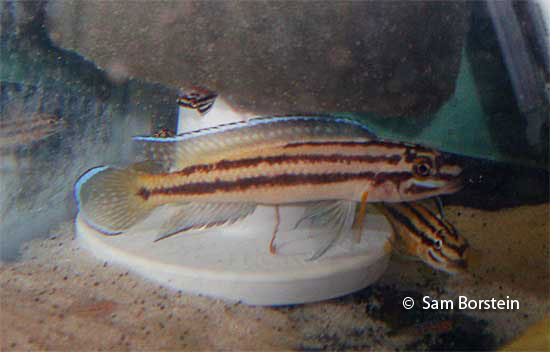Julidochromis sp. "regani kipili"
Kipili Regani

Above: A family of Julidochromis sp. "regani kipili". Photo by Sam Borstein.
Etymology:
Genus- Julidini= a genus of saltwater wrasses this fish resembles (Greek), chromis= perch (Greek).
Species- regani= named after Charles Tate Regan, a British icthyologist.
Intro:
Julidochromis sp. “regani kipili” is a relatively small cave spawner from Lake Tanganyika that is described currently undescribed. Even though this fish does not have much color, it is very interesting in its behavior. The Julidichromis genus often referred to as Julies are peaceful, and exhibit very interesting spawning behaviors. The other bonus of this fish is that it can be kept and bred in small tanks.
Distribution:
Julidochromis sp. “regain kipili” lives in rocky areas of Lake Tanganyika .
Size, Maturity, and Sexual Dimorphism:
Size: Males- 4.5 inches, Females- 3.5 inches
Maturity: 2.5 inches
Sexual Dimorphism: Females are larger.
Care:
Julidochromis sp. “regain kipili” is small and peaceful fish. They will do fine in a community tank, as long as they are put with fish with similar requirements, and are also relatively peaceful. This fish likes hard, alkaline water and the 50% of the water should be changed every two weeks. Decorate the tanks with caves.
Diet:
In the wild, this fish is an omnivore and eats crustaceans and algae. In captivity this fish is easy to feed, just give it a varied diet of flake and pellet foods.
Breeding:
The whole Julidochromis complex has a lot of neat breeding behaviors. A nice thing about these fish is that they will raise numerous broods in a tank; the juvenile fish from the last spawn will even help defend the current spawn.
The pair will usually spawn in a cave that has a relatively small opening. Mine bred in barnacles. The fry are small, and defended well by the parents. The fry are easily raised on baby brine shrimp, and for Tangs grow relatively fast. At about a 1/4 inch, they start to get the pattern on them. You should always feed Julies and Lamprologus baby brine shrimp because they don't let the babies out until they are relatively good size.

Above: A family of Julidochromis regani "Kipili". Photo by Sam Borstein.
Conclusion:
This, along with all Julies are nice fish to keep. If you got a small tank open, give them a try. I personally think this is one of the more attractive Julies available due to the nice yellow body and bright blue fins. It should be a welcome addition to your fishroom if you’re a Tanganyikan fan.
References:
- Konings, A. (1998) Tanganyikan cichlids in their natural habitat. Cichlid Press, El Paso, Texas, 272 pp.
